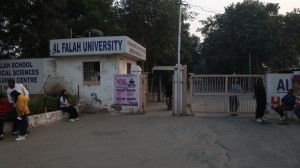Charkha to diamonds: Bullet train stations to depict ethos of state
A deadline of December 2025 has been set for the completion of the civil and construction works of the 508-kilometre-long corridor, popularly known as the Mumbai-Ahmedabad bullet train project.
 Starting from Sabarmati, the bullet train will halt at Ahmedabad, Anand, Vadodara, Bharuch, Surat, Bilimora and Vapi. (File Photo)
Starting from Sabarmati, the bullet train will halt at Ahmedabad, Anand, Vadodara, Bharuch, Surat, Bilimora and Vapi. (File Photo)From Mahatma Gandhi’s humble charkha to exquisite lattice (jaali) of the Sidi Saiyyed mosque, and from the inspiring White Revolution to the radiant Surat diamonds: The eight stations of Mumbai-Ahmedabad High-Speed Rail (MAHSR) Corridor in Gujarat promise to give the travellers a peek into the local designs, culture, and landmark programmes associated with the towns.
A deadline of December 2025 has been set for the completion of the civil and construction works of the 508-kilometre-long corridor, popularly known as the Mumbai-Ahmedabad bullet train project.
Starting from Sabarmati, the bullet train will halt at Ahmedabad, Anand, Vadodara, Bharuch, Surat, Bilimora and Vapi. The facade of each of the stations will be designed to represent the ethos of the respective cities and towns, said authorities.
While the facade of the Sabarmati station is inspired by Mahatma Gandhi’s charkha at the Sabarmati Ashram, in Ahmedabad, the station – with its roof featuring hundreds of kites and facade inspired by the intricate lattice work of Sidi Saiyyed mosque – blends the city’s rich culture with history.
 (LtoR) Mahatma Gandhi’s charkha (spinning wheel), Kites, Sidi Saiyyed mosque jaali (latticework), White Revolution and Banyan (Vad) trees (Express Photo)
(LtoR) Mahatma Gandhi’s charkha (spinning wheel), Kites, Sidi Saiyyed mosque jaali (latticework), White Revolution and Banyan (Vad) trees (Express Photo)
The design of the facade of Anand station, themed on the White Revolution associated with the town where Amul was born, features shapes of milk drops in pristine white. At the next stop, the Vadodara station will reflect the foliage of Banyan trees — from which the city also derives its name. In Bharuch, the facade has been designed to replicate the indigenous Sujani weaves, which date back to 1860 AD and have received a GI tag.
The Surat bullet train station will reflect its “diamond city” tag, with the facade designed to look like diamonds placed together. The station in Bilimora, which is known for its mango orchards, will have a mango yellow colour scheme integrated with white and grey.
The facade of Vapi station on the bullet-train corridor is an abstract depiction of “speed” to represent the rapid industrial growth witnessed by the town.
Stations as ‘vibrant hubs that connect communities’
Managing Director, National High Speed Rail Corporation Limited (NHSRCL), Vivek Kumar Gupta said the intention has been to create stations not for mere transportation but as “vibrant hubs that connect communities” and elevate the overall travel experience.
 (LtoR) Sujani weaves, Mangoes, Speed to reflect the town’s rapid industrialisation and Diamonds
(LtoR) Sujani weaves, Mangoes, Speed to reflect the town’s rapid industrialisation and Diamonds
According to Gupta, “Our idea was to pick some elements of the city that the local residents are proud of. For example, Surat is the epicentre of the global diamond industry while Vadodara is known for its abundance of Banyan (Vad) trees… We have maintained a uniform style at all the stations… This way, we are redefining the role of transportation infrastructure, turning it into a catalyst for economic growth and cultural vibrancy.”
NHSRCL told The Indian Express that the foundation works of all eight stations in Gujarat is complete, adding the work on the superstructures is at an advanced stage.
Earlier, NHSRCL had said, “The bullet train stations are conceived as a gateway to a modern way of living. The design of each of the stations on the MAHSR line will reflect the spirit of the city they are coming up in. This will bring about an instant connection with the local populace, and promote a sense of ownership of the high-speed system.”
On Tuesday, the work on installation of 90 energy efficient escalators at the 12 stations of the corridor commenced with two escalators being set up at Anand bullet train station.
Like the exterior, the interiors of the stations will meet international standards in functionality and operations, said Gupta. NHSRCL said, “The interiors will have soothing colours and all basic amenities like waiting areas, nursery, business-class lounge, smoking rooms, etc.
Some of the stations will be developed as a transport hub through integration with other modes of transportation for better, faster and hassle-free connectivity to and from the station…”The stations will have an inclusive design for specially abled passengers. “A wheelchair-friendly design, lowered ticketing counters with Braille instructions, tiles on the floor for guidance, dedicated washrooms, Braille buttons inside elevators are some of the features,” NHSRCL said.
Gupta said that in order to enhance accessibility and convenience of commuters and stakeholders, and to promote economic activities around the stations area, the surrounding areas of bullet train stations have been planned to develop in accordance with the policies of Transit-Oriented Development (TOD).
“The areas around HSR stations at Sabarmati and Surat in Gujarat, and Virar and Thane in Maharashtra, have also been shortlisted by the respective state authorities for preparation of Station Area Development schemes,” he said.







